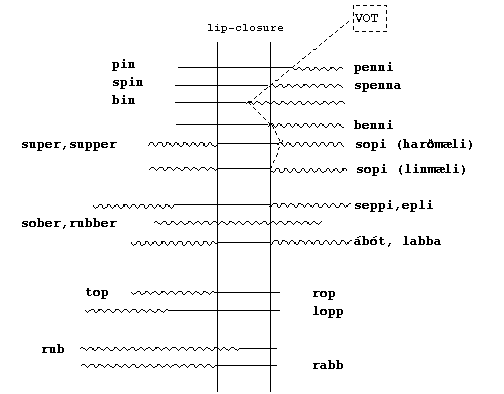We have already seen that UNVOICED consonants clip or shorten preceding vowels - see Clipping
We also saw that there are 8 consonant-pairs in English of voiced-unvoiced consonants. They are these:

These are the sounds heard at the end of the words:
Unvoiced: keep ( ), sweet (
), sweet ( ), leak (
), leak ( ), leaf (
), leaf ( ), path (
), path ( )*, lease (
)*, lease (

 ), leash (
), leash (

 ), leech (
), leech (

 )
)
Voiced: cab (

 ), feed (
), feed (

 ), league (
), league (

 ), leave (
), leave (

 ), bathe (
), bathe (

 ), please (
), please (


 ), rouge (
), rouge (

 ) and bridge (
) and bridge (


 )
)
But the terms VOICING and UNVOICING are a little misleading. While UNVOICED consonants are nearly always unvoiced, VOICED consonants are not always fully voiced - or voiced at all. We find that there are other feature that distinguish between the voiced-unvoiced pairs, and voicing is only one of them.
In this course, then, we will follow Roach and many other British phoneticians and speak of FORTIS and LENIS consonants rather than voiced and unvoiced.
Remember:
- FORTIS consonants are
- unvoiced
- slightly LONGER than lenis consonants
- they can have aspiration (postaspiration in English, pre- and post-aspiration in Icelandic)
- they can be glottalized in English
- they are STRONGER than lenis consonants
- LENIS consonants are
- often voiced (but not always, or not always fully)
- slightly SHORTER than fortis consonants
- are not aspirated (at least not in English and Icelandic)
- are not usually glottalized
- are WEAKER than fortis consonants.
Remember too, that only the 8 pairs above have fortis-lenis distinctions. All the other consonants in English are usually voiced, except for h, which is usually unvoiced.
('Usually' is a useful word. There are usually exceptions to everything.)
Fortis and lenis plosives
With the plosives, the difference between fortis and lenis is mostly a question of voicing and aspiration - at least in English and Icelandic.
AT THE BEGINNING OF WORDS, fortis plosives are POSTASPIRATED, and lenis plosives are not.
Postaspiration is a puff of air - in fact an unvoiced vowel - following the plosive. If you say the words pill, till, kill while holding the back of your hand in front of your mouth you can actually feel this puff of air. We show it with a raised h - 



 ,
, 


 ,
, 



Lenis plosives, however, do not have this aspiration - bib, did, gig

 ,
, 

 ,
, 


Voicing of Icelandic and English plosives
One of the main differences between Icelandic and English lies in the VOICING of the consonants. Icelandic plosives, for instance are ALL UNVOICED, and the difference between fortis and lenis pairs is ONLY a difference of aspiration.
- At the beginning of words:
penni 




 - Benni
- Benni 




tá 


 , dá
, dá 


- Following short vowels, Icelandic fortis plosives have PREASPIRATION, i.e. the puff of air occurs BEFORE the plosive. This doesn't occur in many languages, and you should try not to let it occur in English.
mappa (



 ), gott (
), gott (


 ), rikk (
), rikk (


 )
)
- Final LENIS plosives are UNVOICED in Icelandic (as in many languages like German and Russian), but they are VOICED in English:
Compare Englishrobe (

 ), red (
), red (

 ), leg (
), leg (

 )
)
with Icelandic
rabb (


 ), rödd, (
), rödd, ( ö
ö
 ), ligg (
), ligg (


 )
)
 These last examples incidentally underline another important difference between Icelandic and English: Icelandic consonants can be LONG or SHORT, while there is no length distinction in English consonants. In English, there is the same p in 'super' and 'supper', and the same d in 'lady' and 'laddie':
These last examples incidentally underline another important difference between Icelandic and English: Icelandic consonants can be LONG or SHORT, while there is no length distinction in English consonants. In English, there is the same p in 'super' and 'supper', and the same d in 'lady' and 'laddie':



 -
- 






 -
- 



- In Icelandic MEDIAL lenis plosives are often LONG and always UNVOICED; in English they are short and fully voiced.
Compare
Icelandic 'rabba' 



 - English 'rubber'
- English 'rubber' 



Icelandic 'redda' 



 - English 'ready'
- English 'ready' 



THE FOLLOWING DIAGRAM, which I shall be explaining in class (5th week), shows the difference between the voicing of Icelandic and English plosives:

), sweet (
), leak (
), leaf (
), path (
)*, lease (
), leash (
), leech (
)
), feed (
), league (
), leave (
), bathe (
), please (
), rouge (
) and bridge (
)
,
,
,
,
- Benni
, dá
), gott (
), rikk (
)
), red (
), leg (
)
), rödd, (
ö
), ligg (
)
-

-
- English 'rubber'
- English 'ready'
